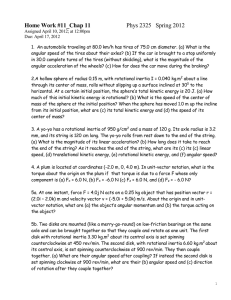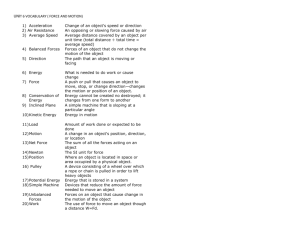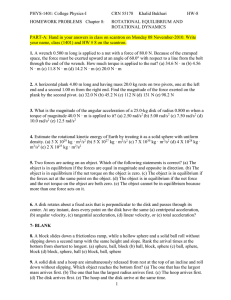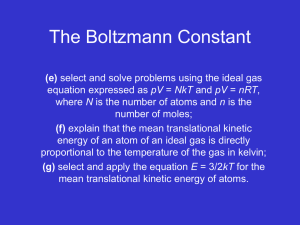CP-S-HW-ch-8-detailed.doc
advertisement
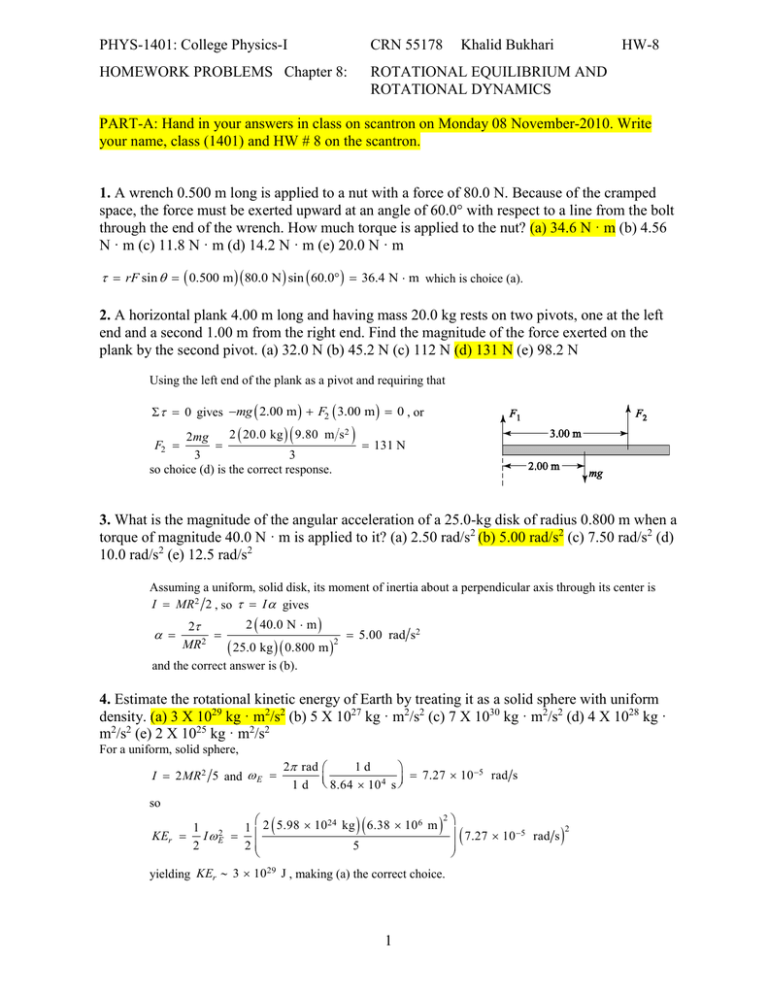
PHYS-1401: College Physics-I CRN 55178 Khalid Bukhari HW-8 HOMEWORK PROBLEMS Chapter 8: ROTATIONAL EQUILIBRIUM AND ROTATIONAL DYNAMICS PART-A: Hand in your answers in class on scantron on Monday 08 November-2010. Write your name, class (1401) and HW # 8 on the scantron. 1. A wrench 0.500 m long is applied to a nut with a force of 80.0 N. Because of the cramped space, the force must be exerted upward at an angle of 60.0° with respect to a line from the bolt through the end of the wrench. How much torque is applied to the nut? (a) 34.6 N · m (b) 4.56 N · m (c) 11.8 N · m (d) 14.2 N · m (e) 20.0 N · m rF sin 0.500 m 80.0 N sin 60.0° 36.4 N m which is choice (a). 2. A horizontal plank 4.00 m long and having mass 20.0 kg rests on two pivots, one at the left end and a second 1.00 m from the right end. Find the magnitude of the force exerted on the plank by the second pivot. (a) 32.0 N (b) 45.2 N (c) 112 N (d) 131 N (e) 98.2 N Using the left end of the plank as a pivot and requiring that 0 gives mg 2.00 m F2 3.00 m 0 , or 2 20.0 kg 9.80 m s2 2mg 3 3 so choice (d) is the correct response. F2 131 N 3. What is the magnitude of the angular acceleration of a 25.0-kg disk of radius 0.800 m when a torque of magnitude 40.0 N · m is applied to it? (a) 2.50 rad/s2 (b) 5.00 rad/s2 (c) 7.50 rad/s2 (d) 10.0 rad/s2 (e) 12.5 rad/s2 Assuming a uniform, solid disk, its moment of inertia about a perpendicular axis through its center is I MR 2 2 , so I gives 2 40.0 N m 2 5.00 rad s2 2 2 MR 25.0 kg 0.800 m and the correct answer is (b). 4. Estimate the rotational kinetic energy of Earth by treating it as a solid sphere with uniform density. (a) 3 X 1029 kg · m2/s2 (b) 5 X 1027 kg · m2/s2 (c) 7 X 1030 kg · m2/s2 (d) 4 X 1028 kg · m2/s2 (e) 2 X 1025 kg · m2/s2 For a uniform, solid sphere, I 2 MR 2 5 and E 2 rad 1d 7.27 10 5 rad s 4 1 d 8.64 10 s so 24 6 1 1 2 5.98 10 kg 6.38 10 m KEr I E2 2 2 5 2 yielding KEr 3 1029 J , making (a) the correct choice. 1 7.27 10 5 rad s 2 PHYS-1401: College Physics-I CRN 55178 Khalid Bukhari HW-8 5. Two forces are acting on an object. Which of the following statements is correct? (a) The object is in equilibrium if the forces are equal in magnitude and opposite in direction. (b) The object is in equilibrium if the net torque on the object is zero. (c) The object is in equilibrium if the forces act at the same point on the object. (d) The object is in equilibrium if the net force and the net torque on the object are both zero. (e) The object cannot be in equilibrium because more than one force acts on it. In order for an object to be in equilibrium, it must be in both translational equilibrium and rotational equilibrium. Thus, it must meet two conditions of equilibrium, namely Fnet 0 and net 0 . The correct answer is therefore choice (d). 6. A disk rotates about a fixed axis that is perpendicular to the disk and passes through its center. At any instant, does every point on the disk have the same (a) centripetal acceleration, (b) angular velocity, (c) tangential acceleration, (d) linear velocity, or (e) total acceleration? In a rigid, rotating body, all points in that body rotate about the axis at the same rate (or have the same angular velocity). The centripetal acceleration, tangential acceleration, linear velocity, and total acceleration of a point in the body all vary with the distance that point is from the axis of rotation. Thus, the only correct choice is (b). 7- BLANK 8. A block slides down a frictionless ramp, while a hollow sphere and a solid ball roll without slipping down a second ramp with the same height and slope. Rank the arrival times at the bottom from shortest to longest. (a) sphere, ball, block (b) ball, block, sphere (c) ball, sphere, block (d) block, sphere, ball (e) block, ball, sphere. When objects travel down ramps of the same length, the one with the greatest translational kinetic energy at the bottom will have the greatest final translational speed (and, hence, greatest average translational speed). This means that it will require less time to travel the length of the ramp. Of the objects listed, all will have the same total kinetic energy at the bottom, since they have the same decrease in gravitational potential energy (due to the ramps having the same vertical drop) and no energy has been spent overcoming friction. All of the block’s kinetic energy is in the form of translational kinetic energy. Of the rolling bodies, the fraction of their total kinetic energy that is in the translational form is 1 M v2 KEt 1 1 f 1 22 1 2 2 KEt KEr Mv 2 I 1 I MR2 1 I M v 2 Since the ratio I/MR2equals 2/5 for a solid ball and 2/3 for a hollow sphere, the ball has the larger translational kinetic energy at the bottom and will arrive before the hollow sphere. The correct rankings of arrival times, from shortest to longest, is then block, ball, sphere, and choice (e) is the correct response. 9. A solid disk and a hoop are simultaneously released from rest at the top of an incline and roll down without slipping. Which object reaches the bottom first? (a) The one that has the largest mass arrives first. (b) The one that has the largest radius arrives first. (c) The hoop arrives first. (d) The disk arrives first. (e) The hoop and the disk arrive at the same time. Please read the answer to Question 8 above, since most of what is said there also applies to this question. The total kinetic energy of either the disk or the hoop at the bottom of the ramp will be KEtotal = Mgh, where M is the mass of the body in question and h is the vertical drop of the ramp. The translational kinetic energy of this body will then be KEt = f KEtotal = fMgh, where f is the fraction discussed in 2 PHYS-1401: College Physics-I CRN 55178 Khalid Bukhari HW-8 Question 8. Hence, M v2 2 f M gh and the translational speed at the bottom is v 2 fgh . Since f = 1/(1+1/2) = 2/3 for the disk and f = 1/(1+1) = 1/2 for the hoop, we see that the disk will have the greater translational speed at the bottom, and hence, will arrive first. Notice that both the mass and radius of the object has canceled in the calculation. Our conclusion is then independent of the object’s mass and/or radius. Therefore, the only correct response is choice (d) 10. A solid cylinder of mass M and radius R rolls down an incline without slipping. Its moment of inertia about an axis through its center of mass is MR2/2. At any instant while in motion, its rotational kinetic energy about its center of mass is what fraction of its total kinetic energy? (a) 12 (b) 14 (c) 13 (d) 25 (e) None of these The ratio of rotational kinetic energy to the total kinetic energy for an object that rolls without slipping is 1 I2 KEr KEr 1 1 2 1 1 2 2 2 2 MR KEtotal KEt KEr M v I M v 2 2 1 1 I I For a solid cylinder, I = MR2/2 and this ratio becomes KEr 1 1 KEtotal 21 3 so the correct answer is (c). (But c = 13, not 1/3. Therefore, correct answer is e) 11. The cars in a soapbox derby have no engines; they simply coast downhill. Which of the following design criteria is best from a competitive point of view? The car’s wheels should (a) have large moments of inertia, (b) be massive, (c) be hoop-like wheels rather than solid disks, (d) be large wheels rather than small wheels, or (e) have small moments of inertia. If a car is to reach the bottom of the hill in the shortest time, it must have the greatest translational speed at the bottom (and hence, greatest average speed for the trip). To maximize its final translational speed, the car should be designed so as much as possible of the car’s total kinetic energy is in the form of translational kinetic energy. This means that the rotating parts of the car (i.e., the wheels) should have as little kinetic energy as possible. Therefore, the mass of these parts should be kept small, and the mass they do have should be concentrated near the axle in order to keep the moment of inertia as small as possible. The correct response to this question is (e). 12. Consider two uniform, solid spheres, a large, massive sphere and a smaller, lighter sphere. They are released from rest simultaneously from the top of a hill and roll down without slipping. Which one reaches the bottom of the hill first? (a) The large sphere reaches the bottom first. (b) The small sphere reaches the bottom first. (c) The sphere with the greatest density reaches the bottom first. (d) The spheres reach the bottom at the same time. (e) The answer depends on the values of the spheres’ masses and radii. Please review the answers given above for questions 8 and 9. In the answer to question 9, it is shown that the translational speed at the bottom of the hill of an object that rolls without slipping is v 2 fgh where h is the vertical drop of the hill and f is the ratio of the translational kinetic energy to the total kinetic energy of the rolling body. For a solid sphere, I 2 MR 2 5 , so the ratio f is f 1 1 I MR2 1 1 1 25 1.4 and the translational speed at the bottom of the hill is v 2gh 1.4 Notice that this result is the same for all uniform, solid, spheres. Thus, the two spheres have the same translational speed at the bottom of 3 PHYS-1401: College Physics-I CRN 55178 Khalid Bukhari HW-8 the hill. This also means that they have the same average speed for the trip, and hence, both make the trip in the same time. The correct answer to this question is (d). 13. A mouse is initially at rest on a horizontal turntable mounted on a frictionless, vertical axle. As the mouse begins to walk clockwise around the perimeter, which of the following statements must be true of the turntable? (a) It also turns clockwise. (b) It turns counterclockwise with the same angular velocity as the mouse. (c) It remains stationary. (d) It turns counterclockwise because angular momentum is conserved. (e) It turns counterclockwise because mechanical energy is conserved. Since the axle of the turntable is frictionless, no external agent exerts a torque about this vertical axis of the mouse-turntable system. This means that the total angular momentum of the mouse-turntable system will remain constant at its initial value of zero. Thus, as the mouse starts walking around the axis (and developing an angular momentum, Lmouse I mm , in the direction of its angular velocity), the turntable must start to turn in the opposite direction so it will possess an angular momentum, Ltable I t t , such that Ltotal Lmouse Ltable I mm I t t 0 . Thus, the angular velocity of the table will be t I m I t m . The negative sign means that if the mouse is walking around the axis in a clockwise direction, the turntable will be rotating in the opposite direction, or counterclockwise. The correct choice for this question is (d). 14. According to the manual of a certain car, a maximum torque of magnitude 65.0 N · m should be applied when tightening the lug nuts on the vehicle. If you use a wrench of length 0.330 m and you apply the force at the end of the wrench at an angle of 75.0° with respect to a line going from the lug nut through the end of the handle, what is the magnitude of the maximum force you can exert on the handle without exceeding the recommendation? (a) 122 N (b) 184 N (c) 204 N (d) 254 N The torque of the applied force is = rF sin. Thus, if r = 0.330 m, = 75.0º, and the torque has the maximum allowed value of max = 65.0 N m, the applied force is F max 65.0 N m 204 N r sin 0.330 m sin 75.0 15. A student gets his car stuck in a snowdrift. Not at a loss, having studied physics, he attaches one end of a stout rope to the car and the other end to the trunk of a nearby tree, allowing for a small amount of slack. The student then exerts a force on the center of the rope in the direction perpendicular to the car-tree line as shown in Figure P8.25. If the rope is inextensible and the magnitude of the applied force is 475 N, what is the force on the car? (Assume equilibrium conditions.) (a) 2.56 kN (b) 2.86 kN (c) 3.04 kN 4 (d) 4.04 kN PHYS-1401: College Physics-I CRN 55178 Khalid Bukhari HW-8 Consider the free-body diagram of the material making up the center point in the rope given at the right. Since this material is in equilibrium, it is necessary to have Fx = 0 and Fy = 0, giving T2 sin T1 sin 0 Fx 0: or T2 = T1, meaning that the rope has a uniform tension T throughout its length. 0.500 m Fy 0: T cos T cos 475 N 0 where cos 6.00 m 2 0.500 m 2 and the tension in the rope (force applied to the car) is 475 N 475 N T 2 cos 6.00 m 2 0.500 m 2 2 0.500 m 2.86 103 N 2.86 kN PART-B: Hand in your solutions to the following questions in class, on Monday 08 November2010 A uniform beam of length 7.60 m and weight 4.50 X 102 N is carried by two workers, Sam and Joe, as shown in Figure P8.8. (a) Determine the forces that each person exerts on the beam. (b) Qualitatively, how would the answers change if Sam moved closer to the midpoint? (c) What would happen if Sam moved beyond the midpoint 8. (a) Since the beam is in equilibrium, we choose the center as our pivot point and require that center FSam 2.80 m FJoe 1.80 m 0 or FJoe 1.56 FSam [1] Also, Fy 0 FSam FJoe 450 N [2] Substitute Equation [1] into [2] to get the following: 450 N 176 N 2.56 1.56 176 N 274 N . FSam 1.56FSam 450 N Then, Equation [1] yields FJoe (b) FSam or If Sam moves closer to the center of the beam, his lever arm about the beam center decreases, so the force FSam must increase to continue applying a clockwise torque capable of offsetting Joe’s counterclockwise torque. At the same time, the force FJoe would decrease since the sum of the two upward forces equal the magnitude of the downward gravitational force. (c) If Sam moves to the right of the center of the beam, his torque about the midpoint would then be counterclockwise. Joe would have to hold down on the beam in order to exert an offsetting clockwise torque. 5 PHYS-1401: College Physics-I CRN 55178 Khalid Bukhari HW-8 22. A hungry 700-N bear walks out on a beam in an attempt to retrieve some “goodies” hanging at the end (Fig. P8.22). The beam is uniform, weighs 200 N, and is 6.00 m long; the goodies weigh 80.0 N. (a) Draw a free-body diagram of the beam. (b) When the bear is at x = 1.00 m, find the tension in the wire and the components of the reaction force at the hinge. (c) If the wire can withstand a maximum tension of 900 N, what is the maximum distance the bear can walk before the wire breaks? (a) See the diagram below (b) If x = 1.00 m, then left end 0 700 N 1.00 m 200 N 3.00 m 80.0 N 6.00 m T sin 60.0° 6.00 m 0 giving T = 434 N. Then, Fx 0 H T cos 60.0° 0 , or H 343 N cos 60.0° 172 N (c) and Fy 0 V 980 N + 343 N sin 60.0° 0 , or V = 683 N. When the wire is on the verge of breaking, T = 900 N and left end 700 N xmax 200 N 3.00 m 80.0 N 6.00 m 900 N sin 60.0° 6.00 m 0 which gives xmax = 5.14 m 31. Four objects are held in position at the corners of a rectangle by light rods as shown in Figure P8.31. Find the moment of inertia of the system about (a) the x-axis, (b) the y-axis, and (c) an axis through O and perpendicular to the page. The moment of inertia for rotations about an axis is I mi ri2 , where ri is the distance mass mi is from that axis. (a) For rotation about the x-axis, I x 3.00 kg 3.00 m 2 .00 kg 3.00 m 2 2 2.00 kg 3.00 m 4.00 kg 3.00 m 99.0 kg m 2 2 (b) 2 When rotating about the y-axis, 6 PHYS-1401: College Physics-I CRN 55178 Khalid Bukhari I y 3.00 kg 2 .00 m 2 .00 kg 2 .00 m 2 HW-8 2 2.00 kg 2.00 m 4.00 kg 2.00 m 44.0 kg m 2 2 (c) is 2 For rotations about an axis perpendicular to the page through point O, the distance ri for each mass 2 .00 m 2 3.00 m 2 ri Thus, 13.0 m IO 3.00 2.00 2.00 4.00 kg 13.0 m2 143 kg m2 40. An Atwood’s machine consists of blocks of masses m1 = 10.0 kg and m2 = 20.0 kg attached by a cord running over a pulley as in Figure P8.40. The pulley is a solid cylinder with mass M = 8.00 kg and radius r = 0.200 m. The block of mass m2 is allowed to drop, and the cord turns the pulley without slipping. (a) Why must the tension T2 be greater than the tension T1? (b) What is the acceleration of the system, assuming the pulley axis is frictionless? (c) Find the tensions T1 and T2. (a) It is necessary that the tensions T1 and T2 be different in order to provide a net torque about the axis of the pulley and produce and angular acceleration of the pulley. Since intuition tells us that the system will accelerate in the directions shown in the diagrams at the right when m2 > m1, it is necessary that T2 > T1. (b) We adopt a sign convention for each object with the positive direction being the indicated direction of the acceleration of that object in the diagrams at the right. Then, apply Newton’s second law to each object: Fy m1a For m2 : Fy m2 a m2 g T2 m2 a m2 For M : I For m1 : Or T1 m1 g a [1] T1 m1g m1a rT2 rT1 I or T2 m2 g a [2] or T2 T1 I r [3] Substitute Equations [1] and [2], along with the relations I Mr 2 2 and a r , into Equation [3] to obtain m2 g a m1 g a and a (c) m2 m1 g m1 m2 M 2 From Equation [1]: T1 From Equation [2]: T2 Mr 2 a Ma 2r r 2 or M m1 m2 2 a m2 m1 g 20.0 kg 10.0 kg 9.80 m s2 2.88 m s2 20.0 kg 10.0 kg + 8.00 kg 2 10.0 kg 9.80 m s2 2.88 m s2 127 N . 20.0 kg 9.80 m s2 2.88 m s2 138 N . 7 PHYS-1401: College Physics-I CRN 55178 Khalid Bukhari HW-8 52. Use conservation of energy to determine the angular speed of the spool shown in Figure P8.52 after the 3.00-kg bucket has fallen 4.00 m, starting from rest. The light string attached to the bucket is wrapped around the spool and does not slip as it unwinds. As the bucket drops, it loses gravitational potential energy. The spool gains rotational kinetic energy and the bucket gains translational kinetic energy. Since the string does not slip on the spool, r where r is the radius of the spool. The moment of inertia of the spool is I 21 Mr 2 , where M is the mass of the spool. Conservation of energy gives KE t KEr PEg f KEt KEr PEg 1 1 m 2 I 2 mgy f 0 0 mgyi 2 2 or 1 11 2 m r Mr 2 2 mg yi y f 2 22 This gives 2mg yi y f m 21 M r 2 i 2 3.00 kg 9.80 m s2 4.00 m 3.00 kg+ 21 5.00 kg 0.600 m 2 10.9 rad s 58. Halley’s comet moves about the Sun in an elliptical orbit, with its closest approach to the Sun being 0.59 A.U. and its greatest distance being 35 A.U. (1 A.U. is the Earth– Sun distance). If the comet’s speed at closest approach is 54 km/s, what is its speed when it is farthest from the Sun? You may neglect any change in the comet’s mass and assume that its angular momentum about the Sun is conserved. Using conservation of angular momentum, Laphelion Lperihelion . mra2 a ra mrp2 p Thus, mra2 a mrp2 p . Since = 1/r at both aphelion and perihelion, this is equivalent to rp rp , giving 0.59 A.U. a p 54 km s 0.91 km s 35 A.U. ra 8 PHYS-1401: College Physics-I CRN 55178 Khalid Bukhari HW-8 60. A playground merry-go-round of radius 2.00 m has a moment of inertia I = 275 kg · m2 and is rotating about a frictionless vertical axle. As a child of mass 25.0 kg stands at a distance of 1.00 m from the axle, the system (merry-go-round and child) rotates at the rate of 14.0 rev/min. The child then proceeds to walk toward the edge of the merry-go-round. What is the angular speed of the system when the child reaches the edge? From conservation of angular momentum: Ichild I m-g-r where I m-g -r 275 kg m2 f f Ichild I m-g-r i i is the constant moment of inertia of the merry-go-round. Treating the child as a point object, I child mr 2 where r is the distance the child is from the rotation axis. Conservation of angular momentum then gives 25.0 kg 1.00 m 2 275 kg m 2 mri2 I m -g -r 14.0 rev min f 2 i 25.0 kg 2.00 m 2 275 kg m 2 mrf I m -g -r or rev 2 rad 1 min f 11.2 1.17 rad s min 1 rev 60.0 s 87. A 4.00-kg mass is connected by a light cord to a 3.00-kg mass on a smooth surface (Fig. P8.87). The pulley rotates about a frictionless axle and has a moment of inertia of 0.500 kg · m2 and a radius of 0.300 m. Assuming that the cord does not slip on the pulley, find (a) the acceleration of the two masses and (b) the tensions T1 and T2. (a) Free-body diagrams for each block and the pulley are given at the right. Observe that the angular acceleration of the pulley will be clockwise in direction and has been given a negative sign. Since I , the positive sense for torques and angular acceleration must be the same (counterclockwise). For m1: Fy may T1 m1g m1 a T1 m1 g a [1] For m2: Fx max T2 m2 a For the pulley: I T2r T1r I a r or [2] I T1 T2 2 a [3] r Substitute Equations [1] and [2] into Equation [3] and solve for a to obtain m1g a 2 I r m1 m2 or a (b) 4.00 kg 9.80 m s2 3.12 m s2 2 2 0.500 kg m 0.300 m 4.00 kg 3.00 kg Equation [1] above gives: T1 4.00 kg 9.80 m s2 3.12 m s2 and Equation [2] yields: T2 3.00 kg 3.12 m s2 9.37 N . 9 26.7 N ,
